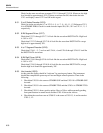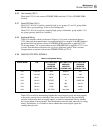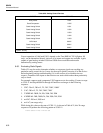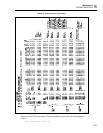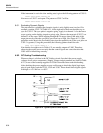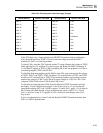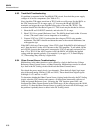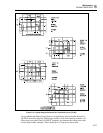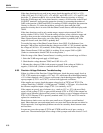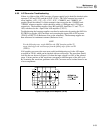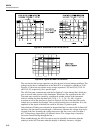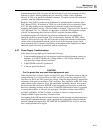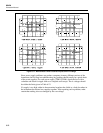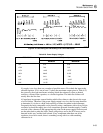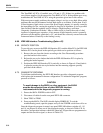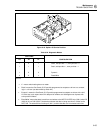
8842A
Instruction Manual
6-58
If the ohms functions do not work in any range, check the supplies at U401 (+/-15V),
U404 (+30V and -5V), U402 (+15V, +5V, and 0V), and U403 (+15V, +5V, and 0V), and
check the -7V reference at R416. Also, test the Ohms Protection circuitry as follows:
Select the 20 kΩ range and 2-wire ohms function, connect a 10 kΩ resistor to the HI and
LO INPUT terminals, and bypass the protection circuitry by connecting the emitter of
Q402 to the junction of R410 and R309. If a reading of 10 kΩ is displayed, the protection
circuitry is defective. To isolate the problem, successively short each part of the
protection circuitry that is in series with the Ohms Current Source, until the display reads
10 kΩ.
If the ohms functions work in only certain ranges, suspect resistor network Z401 or
analog switches U402 or U403. To test the analog switches, select a defective range and
connect a short across the switches that are supposed to be closed in that range. If the
Ohms Current Source then works, one of the analog switches is probably bad. If the
range still doesn’t work, then Z401 is probably bad.
To test the first stage of the Ohms Current Source, short U402-19 to Reference Low
through a 2 kΩ resistor and check that the voltage across R401 is 7.0V (nominal) and that
the voltage at U401-6 is -4V (nominal). If the voltages are correct, the first stage of the
Ohms Current Source (U401 and Q401) is working. If not, suspect U401 or Q401.
(Under no circumstances should U401-6 ever be positive.)
If the first stage of the Ohms Current Source is working, test the second stage as follows:
1. Select the 20 kΩ range and apply a 10 kΩ input.
2. Check that the voltage between TP403 and U402-16 is +5V.
3. Measure the voltage at U404-6 with respect to ground. If the voltage at U404-6 is
negative, U404 is bad. (Under no condition should U404-6 ever be negative.)
6-65. Precision Voltage Reference Troubleshooting
If there is a failure of the Precision Voltage Reference, check the power supply levels at
U702. U702 requires two supplies, +15V and -15V, which must be within approximately
+/-5% of their nominal value. Using an oscilloscope, check that the power supplies and
op amp outputs (U702-1 and U702-7) are free from ripple and oscillations.
If the supplies are correct, check the output voltage levels at TP701 and TP702. The
voltages should be +7.00000V +/-1000 ppm and -7.00000V +/-250 ppm. Also check that
the reference amplifier output voltage (U702-1) is nominally +6.5V.
If the outputs are grossly out of tolerance (e.g., stuck at +15V or -15V), the most likely
cause is a bad op amp (U702) or open resistor network (Z701 or Z702). If the outputs are
slightly out of tolerance, the most likely cause is a defective or out-of-tolerance resistor in
Z701 or Z702. Because Z701 is precisely matched with U701, Z701 and U701 must be
replaced as a matched set.
Shorts between lands or runs can also cause small errors (10 ppm to several hundred
ppm). Shorts between sense and output lands can cause small errors that are not related to
resistor networks. Load regulation problems can also be caused by shorts between sense
and load lines.
In some rare cases, the op amps (U702A and U702B) could be out of spec, causing a
small error. The maximum input offset voltage of the op amps used in the circuit is 3 mV.



